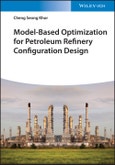An accessible, easy-to-read introduction to the methods of mixed-integer optimization, with practical applications, real-world operational data, and case studies
Interest in model-based approaches for optimizing the design of petroleum refineries has increased throughout the industry in recent years. Mathematical optimization based on mixed-integer programming has brought about the superstructure optimization method for synthesizing petroleum refinery configurations from multiple topological alternatives.
Model-Based Optimization for Petroleum Refinery Configuration Design presents a detailed introduction to the use of mathematical optimization to solve both linear and nonlinear problems in the refining industry. The book opens with an overview of petroleum refining processes, basic concepts in mathematical programming, and applications of mathematical programming for refinery optimization. Subsequent chapters address superstructure representations of topological alternatives, mathematical formulation, solution strategies, and various modeling frameworks. Practical case studies demonstrate refinery configuration design, refinery retrofitting, and real-world issues and considerations.
- Presents linear, nonlinear, and mixed-integer programming approaches applicable to both new and existing petroleum refineries
- Highlights the benefits of model-based solutions to refinery configuration design problems
- Features detailed case studies of the development and implementation of optimization models
- Discusses economic considerations of heavy oil processing, including cash flow analysis of refinery costs and return on capital
- Includes numerical examples based on real-world operational data and various commercial technologies
Model-Based Optimization for Petroleum Refinery Configuration Design is an invaluable resource for researchers, chemical engineers, process and energy engineers, other refining professionals, and advanced chemical engineering students.
Table of Contents
Chapter 1. Introduction to Heavy Oil ProcessingChapter 2. Refinery Basic Economics
2.1. Introduction to Refinery Economics
2.2. Refinery Margin Calculations
2.3. Refinery Return on Capital
2.4. Cash Flow Analysis of Refinery Costs
Chapter 3. Superstructure Representations of Topological Alternatives
3.1. Resource-Task Network (RTN) Superstructure Representation
3.2. State-Task Network (STN) Superstructure Representation
3.3. State-Equipment Network (SEN) Superstructure Representation
3.4. Resource-Technology Network (RTN) Superstructure Representation
Chapter 4. Modeling Framework
4.1. Linear Programming (LP)
4.2. Integer Programming (IP)
4.3. Nonlinear Programming (NLP)
4.4. Mixed-Integer Linear Programming (MILP)
4.5. Mixed-Integer Nonlinear Programming (MINLP)
Chapter 5. Mathematical Formulation
5.1. Constraints
5.2. Objective Function
5.3. Logic Propositions and Problem-Specific Constraints
5.4. User Cuts and Lazy Cuts
Chapter 6. Solution Strategies
6.1. Convex Relaxation
6.2. Lagrangean Decomposition
6.3. Global Optimization Techniques
Chapter 7. Numerical Examples and Case Studies
7.1. Example 1: Refinery Configuration for Processing Naphtha from Atmospheric Distillation
7.2. Example 2: Refinery Configuration for Processing Heavy Crude Oil Feed
7.3. Industrial Case Study 1: Refinery Configuration for Kuwaiti Refineries
7.4. Industrial Case Study 2: Refinery Configuration with Heat Integration and Environmental Considerations
7.5. Industrial Case Study 3: Refinery Configuration for Low-Benzene Fuels Production
Chapter 8. Modeling Extensions and Concluding Remarks








